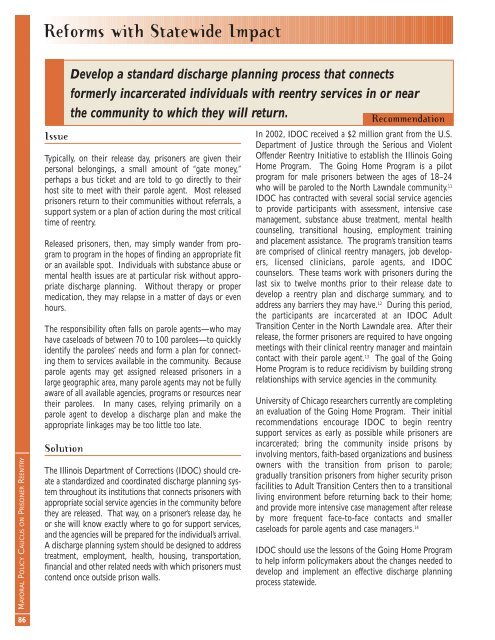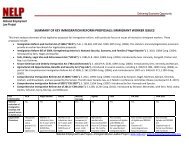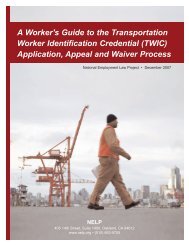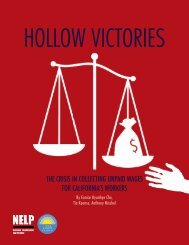Rebuilding Lives. Strengthening Communities.
Rebuilding Lives. Strengthening Communities.
Rebuilding Lives. Strengthening Communities.
Create successful ePaper yourself
Turn your PDF publications into a flip-book with our unique Google optimized e-Paper software.
Reforms with Statewide Impact<br />
MAYORAL POLICY CAUCUS ON PRISONER REENTRY<br />
Issue<br />
Typically, on their release day, prisoners are given their<br />
personal belongings, a small amount of “gate money,”<br />
perhaps a bus ticket and are told to go directly to their<br />
host site to meet with their parole agent. Most released<br />
prisoners return to their communities without referrals, a<br />
support system or a plan of action during the most critical<br />
time of reentry.<br />
Released prisoners, then, may simply wander from program<br />
to program in the hopes of finding an appropriate fit<br />
or an available spot. Individuals with substance abuse or<br />
mental health issues are at particular risk without appropriate<br />
discharge planning. Without therapy or proper<br />
medication, they may relapse in a matter of days or even<br />
hours.<br />
The responsibility often falls on parole agents—who may<br />
have caseloads of between 70 to 100 parolees—to quickly<br />
identify the parolees’ needs and form a plan for connecting<br />
them to services available in the community. Because<br />
parole agents may get assigned released prisoners in a<br />
large geographic area, many parole agents may not be fully<br />
aware of all available agencies, programs or resources near<br />
their parolees. In many cases, relying primarily on a<br />
parole agent to develop a discharge plan and make the<br />
appropriate linkages may be too little too late.<br />
Solution<br />
Develop a standard discharge planning process that connects<br />
formerly incarcerated individuals with reentry services in or near<br />
the community to which they will return.<br />
Recommendation<br />
The Illinois Department of Corrections (IDOC) should create<br />
a standardized and coordinated discharge planning system<br />
throughout its institutions that connects prisoners with<br />
appropriate social service agencies in the community before<br />
they are released. That way, on a prisoner’s release day, he<br />
or she will know exactly where to go for support services,<br />
and the agencies will be prepared for the individual’s arrival.<br />
A discharge planning system should be designed to address<br />
treatment, employment, health, housing, transportation,<br />
financial and other related needs with which prisoners must<br />
contend once outside prison walls.<br />
In 2002, IDOC received a $2 million grant from the U.S.<br />
Department of Justice through the Serious and Violent<br />
Offender Reentry Initiative to establish the Illinois Going<br />
Home Program. The Going Home Program is a pilot<br />
program for male prisoners between the ages of 18–24<br />
who will be paroled to the North Lawndale community. 11<br />
IDOC has contracted with several social service agencies<br />
to provide participants with assessment, intensive case<br />
management, substance abuse treatment, mental health<br />
counseling, transitional housing, employment training<br />
and placement assistance. The program’s transition teams<br />
are comprised of clinical reentry managers, job developers,<br />
licensed clinicians, parole agents, and IDOC<br />
counselors. These teams work with prisoners during the<br />
last six to twelve months prior to their release date to<br />
develop a reentry plan and discharge summary, and to<br />
address any barriers they may have. 12 During this period,<br />
the participants are incarcerated at an IDOC Adult<br />
Transition Center in the North Lawndale area. After their<br />
release, the former prisoners are required to have ongoing<br />
meetings with their clinical reentry manager and maintain<br />
contact with their parole agent. 13 The goal of the Going<br />
Home Program is to reduce recidivism by building strong<br />
relationships with service agencies in the community.<br />
University of Chicago researchers currently are completing<br />
an evaluation of the Going Home Program. Their initial<br />
recommendations encourage IDOC to begin reentry<br />
support services as early as possible while prisoners are<br />
incarcerated; bring the community inside prisons by<br />
involving mentors, faith-based organizations and business<br />
owners with the transition from prison to parole;<br />
gradually transition prisoners from higher security prison<br />
facilities to Adult Transition Centers then to a transitional<br />
living environment before returning back to their home;<br />
and provide more intensive case management after release<br />
by more frequent face-to-face contacts and smaller<br />
caseloads for parole agents and case managers. 14<br />
IDOC should use the lessons of the Going Home Program<br />
to help inform policymakers about the changes needed to<br />
develop and implement an effective discharge planning<br />
process statewide.<br />
86
















